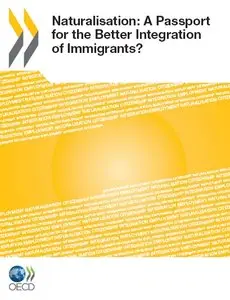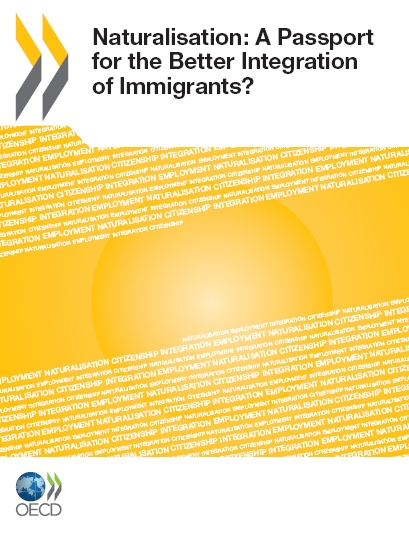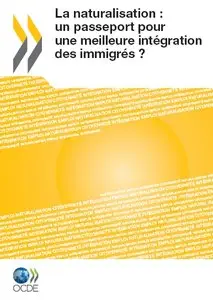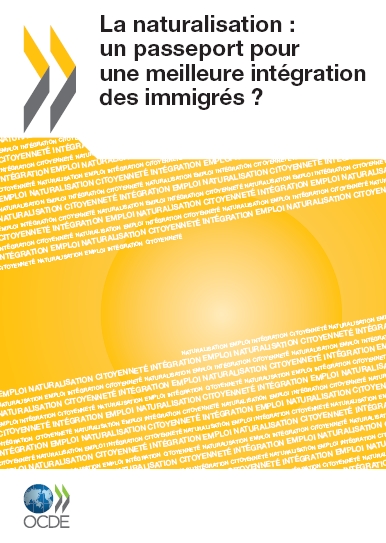Naturalisation: A Passport for the Better Integration of Immigrants?
OECD | Apr 2011 | ISBN: 9264098985 | 358 pages | PDF/djvu | 3 MB
OECD | Apr 2011 | ISBN: 9264098985 | 358 pages | PDF/djvu | 3 MB
This publication takes stock of the current knowledge regarding the links between host-country nationality and the socio-economic integration of immigrants and their children, building on novel evidence on this issue. It also discusses the role of naturalisation as a tool in the overall framework for immigration and integration policy, with the aim of identifying good practices from the different experiences of EU and OECD countries.
PDF: pdf MegaUp Mirror • | • pdf ES Download
DJVU: djvu MegaUp Mirror • | • djvu ES Download
Table of Contents
Main findings of the Joint EC/OECD Seminar on Naturaliastion and the Socio-Economic Integration of Immigrants and their Children by Thomas Liebig
PART I. NATURALISATION AND THE LABOUR MARKET OUTCOMES OF IMMIGRANTS: AN OVERVIEW
Chapter 1. Citizenship and the Socio-economic Integration of Immigrants and their Children: An Overview across EU and OECD Countries by Thomas Liebig and Friederike Von Haaren
-Introduction
-1.1. Citizenship take-up among immigrants
-1.2. The labour market outcomes of naturalised and non-naturalised immigrants
-1.3. Labour market outcomes of children of immigrants and the association with host-country nationality
-1.4. The impact of naturalisation on immigrants’ labour market outcomes
-1.5. Conclusions
-Annex 1.A1. Methodology
-Annex 1.A2. Supplementary tables
Chapter 2. The Current Status of Nationality Law by Nicole Guimezanes
-Introduction
-2.1. Dual nationality
-2.2. Acquisition of nationality at birth
-2.3. Acquisition of nationality by naturalisation
-2.4. Other ways of acquiring nationality
-2.5. Loss of nationality
-2.6. Conclusions
-Annex 2.A1. The main laws on nationality
Annex 2.A2. Supplementary tables
PART II. THE IMPACT OF NATURALISATION ON IMMIGRANTS' LABOUR MARKET INTEGRATION: EXPERIENCE FROM EU AND OECD COUNTRIES
Chapter 3. The Impact of Naturalisation on Labour Market Outcomes in Sweden by Mattias Engdahl
-Introduction
-3.1. General framework on benefits and costs of acquiring Swedish citizenship
-3.2. Data, sample restrictions and empirical specification
-3.3. Labour market outcomes
-3.4. Conclusions
-Annex 3.A1. Variable definitions
-Annex 3.A2. Tables
Chapter 4. How Acquring French Citizenship Affects Immigrant Employment by Denis Fougère and Mirna Safi
-Introduction
-4.1. The acquisition of citizenship and labour market integration in France
-4.2. Measuring the association between naturalisation and immigrants’ access to employment
-4.3. Conclusions
Chapter 5. The Impact of Naturalisation on Immigrant Labour Market Integration in Germany and Switzerland by Max Friedrich Steinhardt
-Introduction
-5.1. Germany
-5.2. Switzerland
Chapter 6. Citizenship Acquisition in Canada and the United States: Determinants and Economic Benefit by Garnett Picot and Feng Hou
-Introduction
-6.1. Becoming a citizen of Canada or the United States
-6.2. Does citizenship acquisition improve economic outcomes?
-6.3. The determinants of naturalisation
-6.4. The rise of a naturalisation rate gap between Canada and the United States
-6.5. Conclusions
Chapter 7. The Labour Market Outcomes of Naturalised Citizens in Norway by Bernt Bratsberg and Oddbjørn Raaum
-Introduction
-7.1. Potential gains and losses from host-country citizenship
-7.2. Data
-7.3. Empirical analysis
-7.4. Discussion
-7.5. Conclusions
PART III. NATURALISATION AND SOCIAL COHESION
Chapter 8. Social Cohesion and Host Country Nationality among Immigrants in Western Europe by Christel Kesler and Neli Demireva
-Introduction
-8.1. Social capital, social cohesion, diversity and citizenship acquisition 8.2. Data source and variables
-8.3. Empirical results
-8.4. Conclusions
-Annex 8.A1. Number of immigrants in the sample
-Annex 8.A2. Additional coefficients
Chapter 9. Naturalisation and Social Inclusion by Pieter Bevelander
-Introduction
-9.1. Social inclusion
-9.2. Consequences of naturalisation
-9.3. Migrant voting: earlier studies
-9.4. Citizenship and voting
-9.5. Conclusions
-Annex 9.A1. Regression results on voting for Swedish residents
Chapter 10. Integration and Access to Nationality in EU Member Countries by Yves Pascouau and Philippe De Bruycker
-Introduction
-10.1. Quantitative approach
-10.2. Knowledge of the language
-10.3. Knowledge of the host society
-10.4. National diversity and European co-ordination
Chapter 11. Naturalisation and the Promotion of the Social Integration of Immigrants in Quebec by Yvan Turcotte
-Introduction
-11.1. Immigration policies aimed at permanent settlement
-11.2. The right of permanent residence and citizenship
-11.3. Access to citizenship: an indicator of integration?
-11.4. Social participation
-11.5. Conclusion: a paradox
PART IV. THE INTERACTIONS BETWEEN NATURALISATION POLICY AND OTHER ELEMENTS OF THE NATIONAL INTEGRATION POLICY MIX
Chapter 12. Policy Interactions in Belgium by Mélanie Knott and Altay Manço
-Introduction
-12.1. Obtaining Belgian nationality through naturalisation: changing conditions
-12.2. Integration and the various indicators for measuring it
-12.3. Conclusion: is naturalisation a means of integration?
Chapter 13. The Legal Frameword on Economic Migration and Naturalisation in the United Kingdom by Chris Hedges
-Introduction
-13.1. Legislative summary
-13.2. Legal provisions in relation to grants of British citizenship
-13.3. Definitions
-13.4. Statistical summary
-3.5. Basis of grant
-3.6. Renunciation of British citizenship
-3.7. Reasons for refusal
-Annex 13.A1. Brief summary of the relevant provisions
Chapter 14. Citizenship in Australia by David Smith, Sanuki Jayarajah, Taya Fabjianic and Janice Wykes
-Introduction
14.1. History of Australian migration, integration and citizenship policies (1900 to present)
-14.2. Citizenship conferrals
-14.3. Characteristics of citizens
-14.4. Variation by birthplace
-14.5. Variation by years since arrival
-14.6. Variation by birthplace and years since arrival
-14.7. The relationship between citizenship and labour market outcomes
-14.8. Do their jobs differ?
-14.9. Impact of the length of stay on the labour market performance
-14.10. Conclusions
Chapter 15. From Assisting to Requiring Integration: Selective Citizenship Policies in the Netherlands by Kees Groenendijk
-Introduction
-15.1. Policy on immigrant integration: twice a new paradigm
-15.2. Acquisition of nationality by naturalisation: restriction, liberalisation, restriction
-15.3. Effects of new rules and tests: numbers and selection
-15.4. The recent close relation between integration and naturalisation policy
-15.5. Effects of naturalisation and integration policy on immigrant integration
with TOC BookMarkLinks
Available in French - "La naturalisation: un passeport pour une meilleure intégration des immigrés ?":
PDF: fr pdf MegaUp Mirror • | • fr pdf ES Download
DJVU: fr djvu MegaUp Mirror • | • fr djvu ES Download
More : You find here





